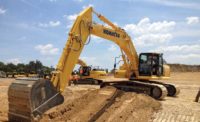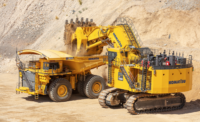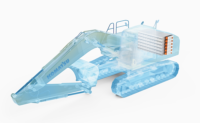

Sensing the heavy-equipment market is ready to move from machine guidance into full machine control, Rolling Meadows, Ill.-based Komatsu America has launched the PC210LCi-10, the first intelligent hydraulic excavator available in North America.
Built on the same technology that runs the D6li-23 intelligent bulldozer unveiled in 2013, the PC210LCi-10 features a semi-autonomous digging mode, which can prevent the operator from working outside of a preset excavation model.
"We think the North American market is ready for excavators with machine controls," says Peter Robson, Komatsu America's senior director for intelligent machine controls. Excavators are available today with machine-guidance systems, in which GPS and laser sensors provide feedback to the operator about where the machine is relative to a preset model. The difference with machine controls is the excavator's hydraulics are linked to the model. Komatsu does this via several in-cylinder hydraulic sensors and an electronically controlled hydraulic valve.
"Talking to customers, one of the largest issues with machine guidance is speed," says Robson. Instead of waiting for a GPS to update or regularly having to recalibrate laser sensors, Komatsu's intelligent excavator operates by dead reckoning checked against the GPS. The system knows the exact dimensions of the excavator's boom and can calculate where the lowest point of the boom is at any given time by monitoring the hydraulic cylinders. "With the in-cylinder stroke sensors, the system has instantaneous knowledge of where the machine is," says Robson. "Its ability to rough-cut close to the design surface is really going to change how customers look at what an excavator can do with machine control."
The limiting is done in the boom's hydraulic cylinder. As an operator pushes on the joystick, the boom will stop when it reaches a predefined grade. The stick's hydraulic cylinder is not limited, so if an operator tries to pull in the stick, the boom will raise to prevent the excavator from digging below the set grade. According to Komatsu, this results in a plus or minus 42-millimeter accuracy. The semi-auto mode can be disabled at any time with a big button at the top of the control console; when the button is pressed, the LCD shows only guidance information.
Komatsu developed the excavator's intelligent machine controls with Topcon Positioning Systems, Livermore, Calif. "The in-cylinder sensors and hydraulic controller are Komatsu-branded, and the GPS guidance system and antennae are Topcon," says Robson. While the excavator's machine controls can be used just by loading models into the cab's computer, it also can be accessed remotely via Topcon's 3D Enterprise software platform, which allows for digging profiles to be updated on the fly. "It's been a collaborative effort with Topcon, and the result is a strong integration," says Robson.
As with its intelligent bulldozers, Komatsu has set a relatively high price premium on the PC210LCi-10, compared to the standard PC210. "It's a significant premium," says Robson. "But it's a premium that the majority of customers will see a return on investment in 12 to 18 months. It's a very justifiable premium."
So how far is Komatsu from fully autonomous heavy equipment? "The typical construction jobsite has multiple layers of variability," says Robson. "I think as we move forward … and efficiencies and alignments on the jobsite change, it does open the door to that possibility."










Post a comment to this article
Report Abusive Comment